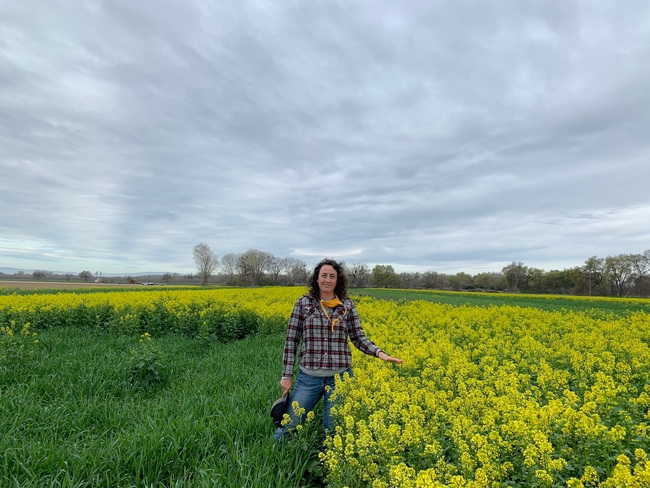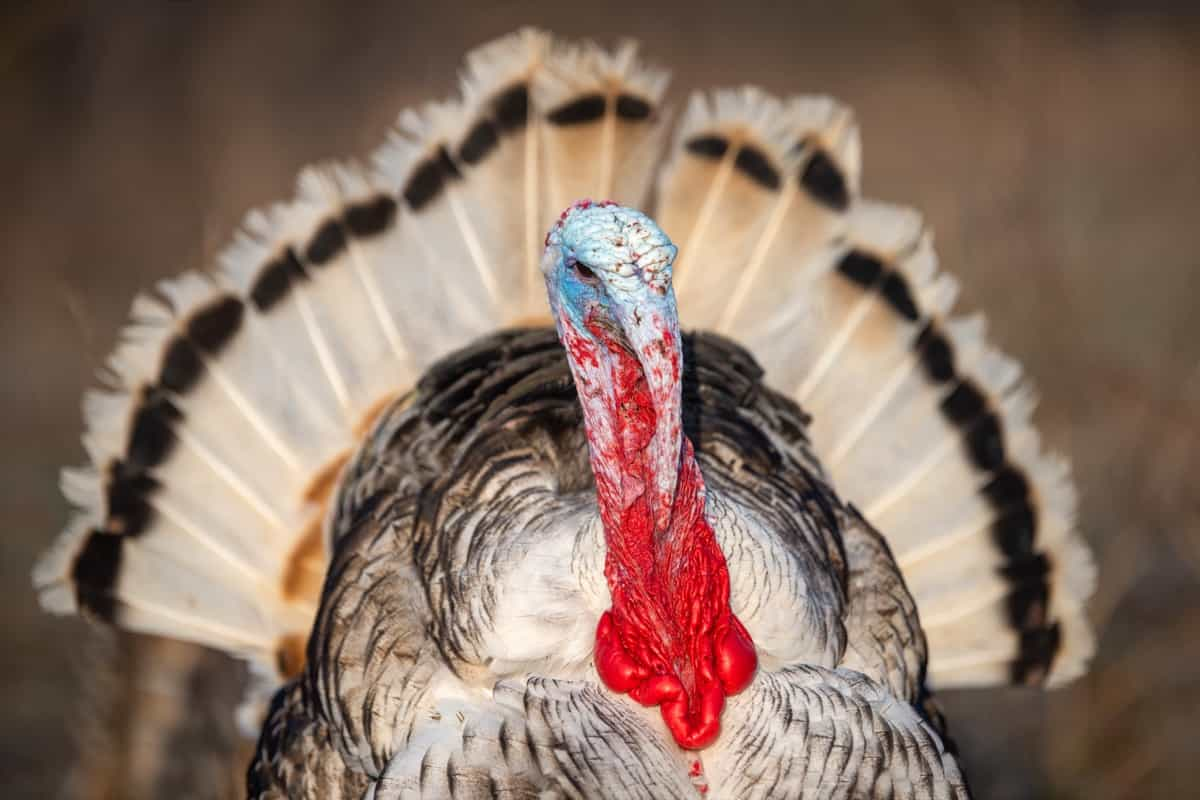New UC study helps growers estimate cover crop costs and potential benefits
Sarah Light stands in a cover crop of white mustard. A new study helps growers estimate the potential costs and benefits of a winter cover crop.
Cover crops offer many potential benefits, including improved soil health, but not knowing the costs can be a barrier for growers wanting to try this practice. To help growers calculate costs per acre, a new study on the potential costs and benefits of adding a winter cover crop to an annual rotation has been released by UC Agriculture and Natural Resources, UC Cooperative Extension and the UC Davis Department of Agricultural and Resource Economics. .
Led by UC Cooperative Extension agricultural advisers Sarah Light and Margaret Lloyd, the cost study is modeled for a crop rotation of vegetable fields planted in 60-inch beds in the lower valley of Sacramento California. Depending on the operation, this rotation may include the processing of tomatoes, corn, sunflowers, cotton, sorghum and dry beans, as well as other annual summer crops.
"This cost study can be used by growers wishing to begin cover cropping to determine the potential costs per acre associated with this soil health practice," said Light, co-author of the study and UC Cooperative Extension agronomy advisor for Sutter. , Yuba and Colusa counties.
"Based on interviews with growers who currently use cover crops on their operations, this cost study models a common management scenario for the Sacramento Valley. Additionally, growers who wish to use cover crops can gain insight into standard field management practices, from planting to harvest."
In the hypothetical farm, the cover crop is sown into dry soil using a grain drill and then depends on rainfall for germination and growth.
"Given the frequency of drier winters, we included the cost of irrigation every third year," Lloyd said.
A mixture of 30% bell bean, 30% field pea, 20% vetch and 20% oat is sown in the fall. Depending on winter rainfall, soil moisture, and the next cash crop, the cover crop is completed in mid to late spring. The cover crop is flailed and disc cut to incorporate the residue into the soil.
The study includes detailed information on the potential benefits and drawbacks of cover cropping.
Another consideration for growers is that several programs such as CDFA's Healthy Soils program, various USDA-funded programs (EQUIP, Climate-Smart Commodities, etc.), and Seeds for Bees by Project Apis m.provide financial incentives for growers to implement conservation practices, such as cover crops.
"This study can provide growers with a basis for estimating their own costs of using winter cover crops as a practice. This can be useful in calculating more accurate estimates when requesting some of these programs and/or weigh costs per acre with expected benefits in terms of soil health, crop insurance premium discounts or other benefits provided by cover crops,” said Brittney Goodrich, UC Cooperative Extension specialist in agriculture and resource economics and co-author of the study.
"Last year, the USDA's Pandemic Cover Crop program provided up to $5/acre off crop insurance premiums for growers who planted a cover crop, and it is possible that this will be extended in the future," Goodrich said.
A list of links to resources that specifically focus on cover crops is included in the review. Five tables show the individual costs of each cultural operation from land preparation to planting and incorporation of residues.
The new study, “2022 – Estimated Costs and Potential Benefits of a Winter Cover Crop in an Annual Crop Rotation – Lower Sacramento Valley,” can be downloaded from the Department of Agricultural Economics website and UC Davis resources at costtudies.ucdavis. edu. Sample production cost studies for many other products are also available on the website.
This cost-benefit study is funded by the Department of Agricultural and Resource Economics, University of California, Davis.
For an explanation of the calculations used in the study, see the section entitled "Assumptions". For more information, contact Don Stewart of the Department of Agricultural and Resource Economics at destewart@ucdavis.edu, Light...


Sarah Light stands in a cover crop of white mustard. A new study helps growers estimate the potential costs and benefits of a winter cover crop.
Cover crops offer many potential benefits, including improved soil health, but not knowing the costs can be a barrier for growers wanting to try this practice. To help growers calculate costs per acre, a new study on the potential costs and benefits of adding a winter cover crop to an annual rotation has been released by UC Agriculture and Natural Resources, UC Cooperative Extension and the UC Davis Department of Agricultural and Resource Economics. .
Led by UC Cooperative Extension agricultural advisers Sarah Light and Margaret Lloyd, the cost study is modeled for a crop rotation of vegetable fields planted in 60-inch beds in the lower valley of Sacramento California. Depending on the operation, this rotation may include the processing of tomatoes, corn, sunflowers, cotton, sorghum and dry beans, as well as other annual summer crops.
"This cost study can be used by growers wishing to begin cover cropping to determine the potential costs per acre associated with this soil health practice," said Light, co-author of the study and UC Cooperative Extension agronomy advisor for Sutter. , Yuba and Colusa counties.
"Based on interviews with growers who currently use cover crops on their operations, this cost study models a common management scenario for the Sacramento Valley. Additionally, growers who wish to use cover crops can gain insight into standard field management practices, from planting to harvest."
In the hypothetical farm, the cover crop is sown into dry soil using a grain drill and then depends on rainfall for germination and growth.
"Given the frequency of drier winters, we included the cost of irrigation every third year," Lloyd said.
A mixture of 30% bell bean, 30% field pea, 20% vetch and 20% oat is sown in the fall. Depending on winter rainfall, soil moisture, and the next cash crop, the cover crop is completed in mid to late spring. The cover crop is flailed and disc cut to incorporate the residue into the soil.
The study includes detailed information on the potential benefits and drawbacks of cover cropping.
Another consideration for growers is that several programs such as CDFA's Healthy Soils program, various USDA-funded programs (EQUIP, Climate-Smart Commodities, etc.), and Seeds for Bees by Project Apis m.provide financial incentives for growers to implement conservation practices, such as cover crops.
"This study can provide growers with a basis for estimating their own costs of using winter cover crops as a practice. This can be useful in calculating more accurate estimates when requesting some of these programs and/or weigh costs per acre with expected benefits in terms of soil health, crop insurance premium discounts or other benefits provided by cover crops,” said Brittney Goodrich, UC Cooperative Extension specialist in agriculture and resource economics and co-author of the study.
"Last year, the USDA's Pandemic Cover Crop program provided up to $5/acre off crop insurance premiums for growers who planted a cover crop, and it is possible that this will be extended in the future," Goodrich said.
A list of links to resources that specifically focus on cover crops is included in the review. Five tables show the individual costs of each cultural operation from land preparation to planting and incorporation of residues.
The new study, “2022 – Estimated Costs and Potential Benefits of a Winter Cover Crop in an Annual Crop Rotation – Lower Sacramento Valley,” can be downloaded from the Department of Agricultural Economics website and UC Davis resources at costtudies.ucdavis. edu. Sample production cost studies for many other products are also available on the website.
This cost-benefit study is funded by the Department of Agricultural and Resource Economics, University of California, Davis.
For an explanation of the calculations used in the study, see the section entitled "Assumptions". For more information, contact Don Stewart of the Department of Agricultural and Resource Economics at destewart@ucdavis.edu, Light...
What's Your Reaction?













![Three of ID's top PR executives quit ad firm Powerhouse [EXCLUSIVE]](https://variety.com/wp-content/uploads/2023/02/ID-PR-Logo.jpg?#)







